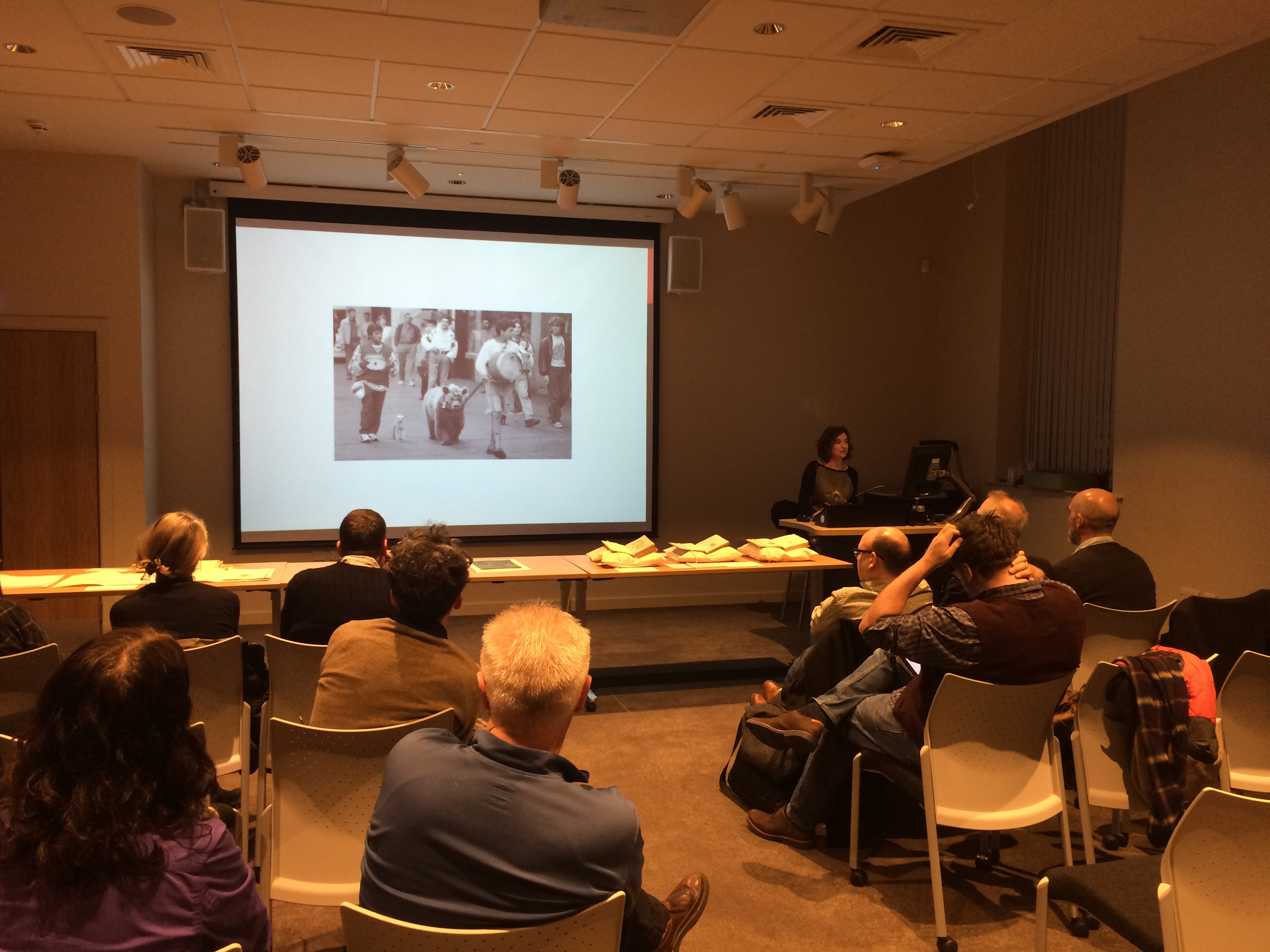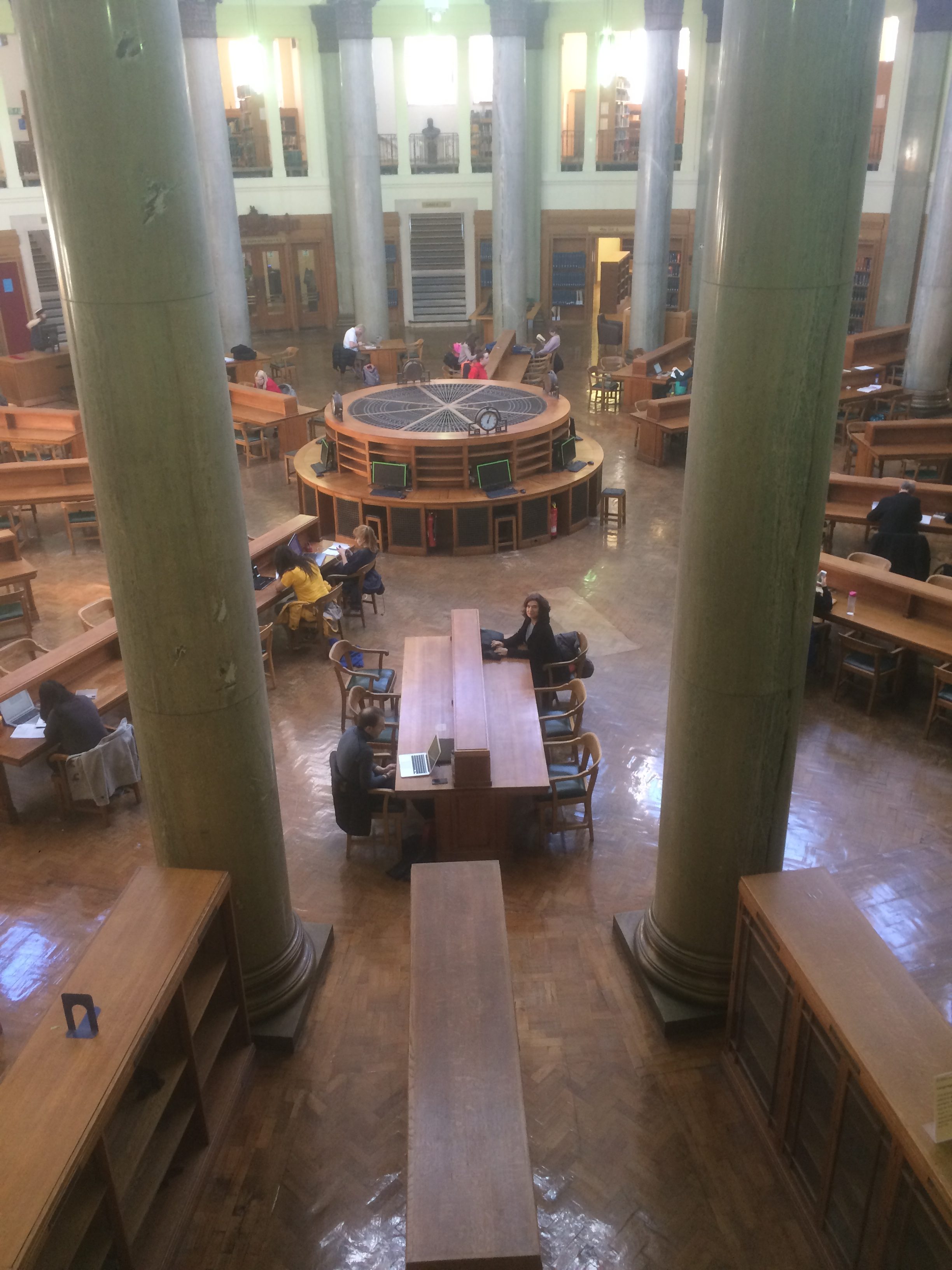«Why we need Romani history. Endeavours to conduct collaborative research» was the title of the lecture given by María Sierra on January 30 in the Treasures of the Brotherton Gallery of the University of Leeds. With this disturbing sentence, she introduced several reflections in relation to our research project, beginning with the question of why it is often said that Roma people have no history. As María Sierra explained, this affirmation –coined by the English writer George Borrow– reflects how modern societies have understood Roma as nomadic and illiterate people without historical consciousness; people who didn’t (and still don’t) fit in a concept of History made from the colonialist and excluding western perception.
 María Sierra during her intervention in the Treasures of the Brotherton Gallery of the University of LeedsAs a result, the history of the Roma people remains to be unwritten nowadays, so it would be worthy to ask ourselves how can we face the challenge of helping to recuperate and create it. According to María Sierra proposal, we must start by questioning how our hegemonic historiographical rules have consolidated a strong hierarchy of subjects where Gypsies are seen as annoying or pointless group. By doing so, we will be able to deconstruct the deeply rooted stereotypes that prevent us from knowing the real people that historically had lived their lives as Gypsies. Both biographical approaches and life stories could be truly useful instruments for this task, given its potential to reveal the richness and the diversity of Romani (past and current) lives. In this regard, it would be crucial to consider the wide interest that Romani people have shown in knowing their history and, moreover, in having voices to tell it.
María Sierra during her intervention in the Treasures of the Brotherton Gallery of the University of LeedsAs a result, the history of the Roma people remains to be unwritten nowadays, so it would be worthy to ask ourselves how can we face the challenge of helping to recuperate and create it. According to María Sierra proposal, we must start by questioning how our hegemonic historiographical rules have consolidated a strong hierarchy of subjects where Gypsies are seen as annoying or pointless group. By doing so, we will be able to deconstruct the deeply rooted stereotypes that prevent us from knowing the real people that historically had lived their lives as Gypsies. Both biographical approaches and life stories could be truly useful instruments for this task, given its potential to reveal the richness and the diversity of Romani (past and current) lives. In this regard, it would be crucial to consider the wide interest that Romani people have shown in knowing their history and, moreover, in having voices to tell it.
All these aspects have been taking into account in our research project PENDARIPEN. Our multidisciplinary and multinational team (you can check us out in Equipo) had already published some special issues and are currently working in new ones regarding fields like the history of anti-Gypsysm, the cultural building and political use of stereotypes, or the reactions of the mainstream society faced with the Romani minority. As María Sierra concluded, trying to explore Romani History from within is been a challenging as well as fascinating purpose which help us to ask ourselves about our way of thinking the past and the social utility of the History we tell.
****
«¿Por qué necesitamos una historia gitana? Razones para un proyecto colectivo» ha sido el título de la conferencia ofrecida por María Sierra el pasado 30 de enero en la Treasures of the Brotherton Gallery de la Universidad de Leeds. Partiendo de esta provocadora pregunta, introdujo una serie de reflexiones relacionadas con nuestro proyecto de investigación, comenzando por la cuestión de por qué ha sido comúnmente aceptada la idea de que los gitanos no tienen historia. Como María Sierra explicó, esta afirmación –acuñada por el escritor inglés George Borrow– es un reflejo del modo en que las sociedades modernas han pensado a los gitanos como un grupo de individuos nómadas, iletrados y sin conciencia histórica; individuos que no encajaron (y aún hoy siguen sin hacerlo) en una noción de Historia fabricada desde una percepción colonialista y excluyente.
En consecuencia, la historia de los gitanos ha permanecido sin ser escrita hasta nuestros días, por lo que merecería la pena preguntarse cómo María Sierra consulting the documents of Sir Angus Fraser’s Legacy archive. We would like to thank the help of Tim Procter, Collections and Engagement Manager (Archives and Manuscripts) of the Brotherton Library. podemos enfrentar el reto de colaborar en su recuperación y narración. Según ha señalado María Sierra, deberíamos empezar por cuestionar de qué modo la hegemonía de nuestros cánones historiográficos ha consolidado una fuerte jerarquización de sujetos en la que los gitanos aparecen como un grupo cuya presencia resulta incómoda o irrelevante. De esta forma, seremos capaces de deconstruir aquellos estereotipos que, por su profundo enraizamiento, nos impiden conocer cómo son las personas reales que históricamente han vivido sus vidas como gitanos. Tanto la biografía como las historias de vida pueden resultar instrumentos útiles para este propósito, dado su potencial para revelar la riqueza y la diversidad de las vidas gitanas. En este sentido, resultará igualmente crucial no perder de vista el amplio interés que los mismos gitanos han mostrado por conocer su historia y, sobre todo, por tener voz propia en su relato.
María Sierra consulting the documents of Sir Angus Fraser’s Legacy archive. We would like to thank the help of Tim Procter, Collections and Engagement Manager (Archives and Manuscripts) of the Brotherton Library. podemos enfrentar el reto de colaborar en su recuperación y narración. Según ha señalado María Sierra, deberíamos empezar por cuestionar de qué modo la hegemonía de nuestros cánones historiográficos ha consolidado una fuerte jerarquización de sujetos en la que los gitanos aparecen como un grupo cuya presencia resulta incómoda o irrelevante. De esta forma, seremos capaces de deconstruir aquellos estereotipos que, por su profundo enraizamiento, nos impiden conocer cómo son las personas reales que históricamente han vivido sus vidas como gitanos. Tanto la biografía como las historias de vida pueden resultar instrumentos útiles para este propósito, dado su potencial para revelar la riqueza y la diversidad de las vidas gitanas. En este sentido, resultará igualmente crucial no perder de vista el amplio interés que los mismos gitanos han mostrado por conocer su historia y, sobre todo, por tener voz propia en su relato.
Todos estos aspectos han sido tenidos en cuenta en el proyecto PENDARIPEN. Nuestro multidisciplinar e internacional equipo (puedes conocernos en Equipo) ha publicado ya algunas investigaciones dedicadas a estas cuestiones y actualmente prepara nuevos trabajos en relación a temáticas como la historia del antigitanismo, la construcción cultural y política de los estereotipos, o las reacciones de la sociedad mayoritaria frente a la minoría gitana. Como María Sierra afirmaba para concluir, tratar de explorar la historia de los gitanos desde dentro está resultando un reto exigente a la par que ilusionante que nos invita a preguntarnos tanto por nuestro modo de pensar el pasado como por la ultilidad social de la Historia que contamos.



